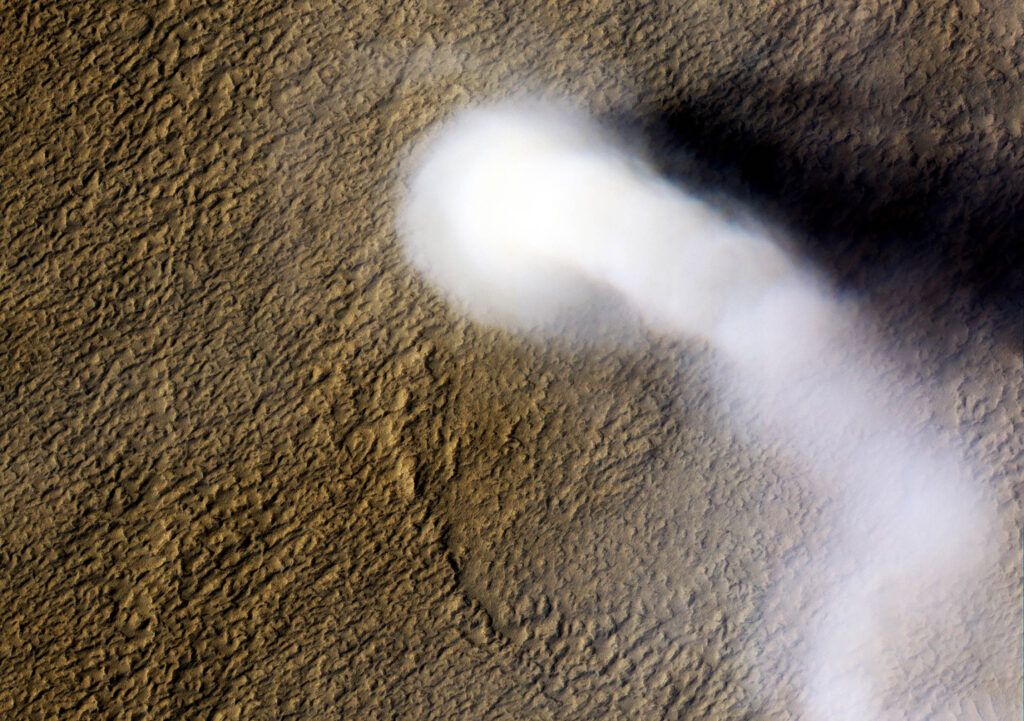
Scientists have recently unveiled a groundbreaking study that tracks 1,039 dust devils—tornado-like whirlwinds—on Mars, offering unprecedented insights into the Red Planet’s atmospheric dynamics. This research, conducted by a team of experts from the University of Bern, leverages two decades of images from the European Space Agency’s Mars Express and ExoMars Trace Gas Orbiter.
By meticulously analyzing these images, the team has created the first comprehensive catalog documenting both the locations and velocities of these dust devils. This new dataset provides a fresh, planet-wide perspective on Martian winds and the mechanisms by which dust is lifted into the atmosphere.
Tiny Twisters, Massive Impact
On Mars, dust plays a crucial role in shaping the planet’s climate. Airborne particles can dim sunlight during the day, trap heat at night, and even contribute to cloud formation. In the absence of rain to cleanse the air, dust circulates persistently around the globe. Understanding the dynamics of dust lifting is essential not only for decoding Martian weather but also for planning future missions, as dust can affect solar panels, cameras, and radiators.
Hunting for Dust Devils on Mars
Under the leadership of Valentin Bickel, the research team employed a neural network to identify dust devils in the vast archives of orbital images. Utilizing data from Mars Express dating back to 2004 and ExoMars TGO images captured since 2016, they pinpointed 1,039 dust devil events and measured the direction and speed for 373 of them. The findings reveal that dust devils can form almost anywhere on Mars, from crater floors to the flanks of giant volcanoes, with a notable concentration in regions like Amazonis Planitia.
Mars Wind: Faster Than Expected
By tracking the movement of these whirlwinds across successive image channels, researchers recorded surface winds reaching up to 44 meters per second (approximately 158 miles per hour). These speeds surpass those measured by in situ rovers and exceed predictions from current Mars weather models. Although the thin Martian atmosphere means these winds don’t have the same force as on Earth, they are significant for dust lifting, suggesting that more material may be entering the atmosphere than previously thought.
Mars’ Clock of Wind and Dust
Similar to Earth, dust devils on Mars follow a seasonal and daily pattern. They are most prevalent in the spring and summer of each hemisphere, peaking from late morning to early afternoon. Although individual whirlwinds last only a few minutes, their cumulative effect continually replenishes the atmosphere with fine dust.
Clever Techniques Reveal Hidden Motion
Neither Mars Express nor TGO was originally designed to measure wind. However, the innovative approach taken by researchers exploits the way these spacecrafts’ cameras construct images. Each picture is composed of multiple narrow channels captured in quick succession. If the ground remains still, these channels align perfectly. However, if a dust devil or cloud moves, tiny offsets appear, which can be used to measure movement.
On Mars Express, the delay between channels ranges from 7 to 19 seconds, allowing scientists to observe dust devils moving across the terrain. TGO’s paired views, taken one second apart for color and 46 seconds apart for stereo, enable the tracking of longer displacements, offering a broader perspective.
Winds Guide Future Mars Landings
Integrating these wind measurements into global circulation models is expected to enhance forecasts of dust lifting and movement. This information is crucial for mission planning, as understanding local wind conditions helps engineers prepare for the challenges faced by solar-powered rovers, parachutes, and other equipment. ESA’s Rosalind Franklin rover, set to land in 2030, is already being scheduled to avoid peak global dust storm seasons.
A Living Atlas of Martian Twisters
The public catalog of dust devils is continuously expanding as both orbiters continue to capture images of the Martian surface. With knowledge of the hotspots and times when dust devils are most likely to appear, researchers can target their observations more precisely. Coordinated campaigns, capturing the same dust devil simultaneously with different instruments, will provide powerful new comparisons and insights into how these whirlwinds change with terrain, season, and time of day.
“Dust devils make the normally invisible wind visible,” Bickel said. With this work, scientists have turned those fleeting signatures from curiosities in rover albums into data points woven into a global tapestry.
From improving climate models to refining landing plans, and from maintaining solar panels to understanding cloud formation, Mars’ smallest storms are providing valuable insights into the planet’s atmospheric system. The full study is published in the journal Science Advances.
—
Like what you read? Subscribe to our newsletter for engaging articles, exclusive content, and the latest updates. Check us out on EarthSnap, a free app brought to you by Eric Ralls and Earth.com.







